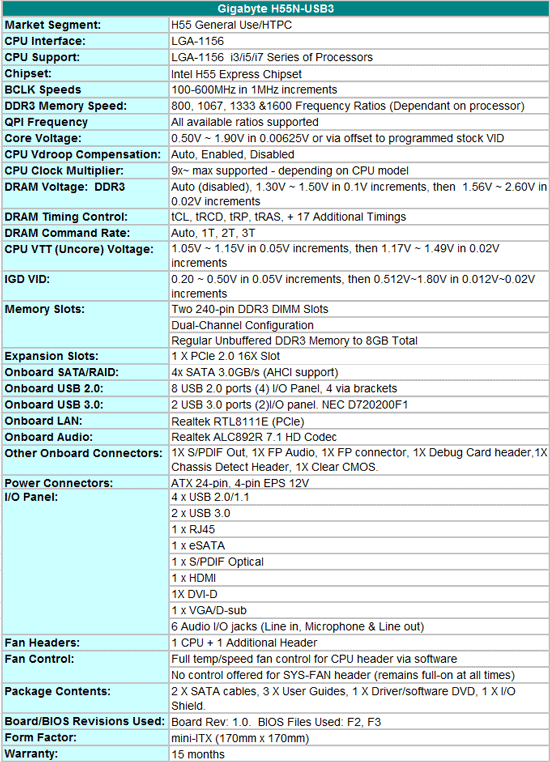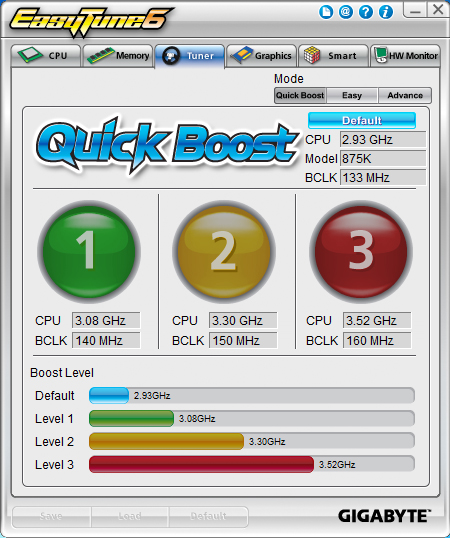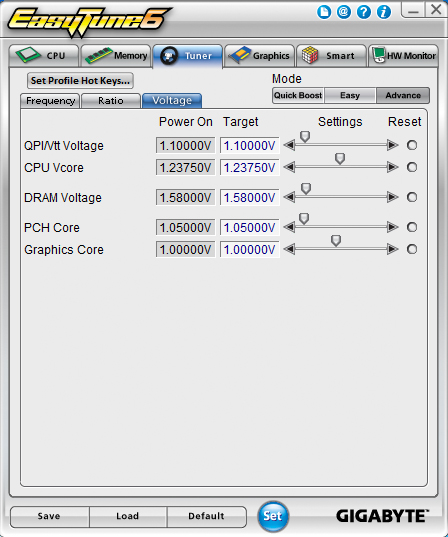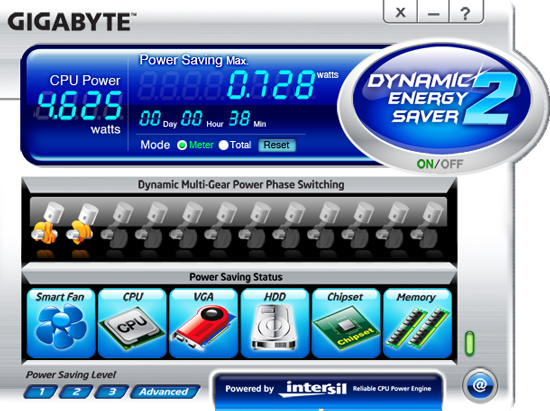Gigabyte H55N-USB3 : Mini-ITX done the Gigabyte way...
by Rajinder Gill on June 15, 2010 7:49 AM EST- Posted in
- Motherboards
- Intel
- Gigabyte
- Mini ITX

Gigabyte’s component choices are very much in-line with what we find on their similarly priced micro-ATX boards; Realtek’s 8111E LAN and a couple of USB 3 ports supplied courtesy of NEC’s D720200F1 controller. All USB ports receive Gigabyte’s 3X power treatment, in that a single port can supply up to 1.5 amps in current for high power devices, which helps reduce charging times and the use of more devices in tandem without facing power dropouts to the USB hub. On/off charge is another function Gigabyte is keen to promote as a facet of the H55N-USB3’s capabilities. This feature allows you to charge devices such as an iPad or iPod even when the board is in standby state.
Audio duties are also taken care by Realtek, this time it's the new ALC892R, although we’re not provided with the Dolby Theater package that Gigabyte bundles with their micro-ATX motherboards. Gamers would probably have welcomed some kind of EAX package to improve game sonics as there’s no upgrade path other than USB audio if wanting better sound when a discrete GPU occupies the lone PCIe slot.
The package bundle contains the standard affair; a couple of SATA cables, and three manuals. The mainboard manual is actually very comrephensive and well written, which should help users get to grips with a new build easily.
Software
Gigabyte bundles an extensive range of software with their motherboards and the H55N-USB3 is no exception to the rule. We tried them all out, and most of them do work as intended. We’ve picked out a few to discuss our thoughts and findings below:

As the name suggest Smart 6 features six tools. Smart QuickBoot saves a few seconds in boot time, bypassing some of the hardware detection routines during POST. The second mode of this software simply engages S3 or S4 hibernation modes on normal power down, so it’s just a one-touch break out GUI, of something you could do via Control Panel Power Options in Windows 7.
Smart QuickBoost is a one-touch overclocking utility with three speed presets. The presets themselves do work, although the higher speed presets may not be ideal for every CPU. We found preset “3” worked fine on our i5-661, but was not stable with our i7-875K Lynnfield, which needs more voltage than the software applies.
SMART Recovery is a backup utility allowing user to setup backup schedules and to restore or copy files from one drive to another. Again, this is something that you can do via Windows 7 easily enough if need be, adding files and folders to a backup schedule as necessary.
SMART Dual BIOS is utility that allows users to save up to twelve passwords and small reminders (with a reminder schedule) to a location in the system BIOS. We’re not sure how much need there is for something like this, but the utility does work.
SMART Recorder is an admin level monitoring tool that records system events such as file access and system on/off events.
Finally there’s SMART TimeLock, which is a user account logon utility that allows limits to be imposed on individual computer accounts. A similar feature is built-in to Windows 7, so we can’t see much need for it.


OC Tuner allows on-the-fly adjustment of system busses as well as changes and monitoring of primary rail voltages. SMART QuickBoost is also built into this utility and offers the same feature as what you get in the Smart 6 version. Most of what is in OC Tuner works, the exception being a misreport of VTT we encountered on occasion. Setting 1.15V in BIOS is seen as 1.10V in OC-Tuner, we tried setting 1.15V in the software and found the scale reverted to 1.10V every time we pressed the “Set” button. It’s the only voltage step in the scale with this problem; you can set above or below 1.15V fine.

Dynamic Energy Saver 2, enables light load power savings by switching some of the VCC power phases off during light load conditions. This can help save a few watts of power on some motherboards, but does not do a lot for the H55N-USB 3 as the PWM circuit used for CPU VCC is three phase and does not use a high switching frequency – so switching losses aren’t that large to begin with . Custom tuning options are also available that allow underclocking BCLK by up to 30% in idle~light load scenarios, although we could not get this to work for us. The software prompted us to reboot as if we set the low power state option, but any changes made would not actually engage upon reboot. Either we’re missing something, or the software needs some work...
BIOS
Gigabyte’s BIOS is well laid out and easy to navigate. The MIT section is home to all overclocking related functions with individual sections neatly segregated and well arranged. Unlike other mini-ITX boards, Gigabyte provides access to almost every memory sub-timing for adjustment.
Voltage control is provided for CPU VCore, VTT, VDIMM, PCH and VAXG. The range for CPU VCore starts from 0.5V and extends out all the way to an insane 1.90V, which is more than anyone will realistically be able to use given this board’s intended audience. The low voltage options will certainly bring a smile to the face of ultra-low power enthusiasts and underclocking nuts. Most mini-ITX motherboards tend to skimp out on the low voltage stuff, so Gigabyte are creating some extra appeal for the H55N-USB by catering for such use.
Eight BIOS profile save locations are provided, as well as an option to save profiles to HDD or a USB drive. Again, these are the finer features you miss out on if you opt for a mini-ITX board from another vendor.
Fan control is one area where we’d liked to have seen more than what you get on the H55N-USB3. The CPU header can control four pin and three pin fans, but the system fan header cannot be controlled at all. CPU fan header control is a little limited in BIOS (Smart fan or disabled modes only, no direct temp scale controls), but you do get a very comprehensive software level control feature in Gigabyte’s OC Tuner utility.
A built in BIOS flashing utility called Q-Flash is available, making BIOS updating a breeze - you can flash a new BIOS from a USB drive or from a HDD.
One last thing worth mentioning; overclocking recovery on this board is excellent. Push things too far and the automated recovery routine will recover the board to POST in safe-mode, negating the need to clear CMOS when overclocking. We tried hard to create a non-POST situation by ramping bus freqeuncies way beyond stable limits and found the BIOS recovered every time. This rounds off the BIOS very nicely, with our only real complaint relating to the strange multiplier control issue on our i7-875K as mentioned in the summary section.
















77 Comments
View All Comments
mongoosesRawesome - Wednesday, June 16, 2010 - link
use the integrated graphics (freeing up the PCIe) and a USB for the wireless. Or use a USB TV tuner with USB wireless, and then use whatever graphics you want. If you need extra expansion, mini-itx isn't for you.Barnaby W. Füi - Wednesday, June 16, 2010 - link
Newegg shows this board as using the Realtek 8111E LAN chipset. Doesn't the H55 already include gigabit LAN? Why wouldn't they use that?Taft12 - Wednesday, June 16, 2010 - link
Nearly all H55 motherboards use that crummy Realtek chip and it must be even cheaper than wiring up the integrated Intel networkRajinder Gill - Thursday, June 17, 2010 - link
I hear the Intel NIC costs as much on it's own to implement, as it does to buy the Realtek audio and LAN ICs as a pair (price break and volume purchase incentives). There's your reason.-Raja
pectin232 - Monday, September 20, 2010 - link
Raja can you help with BIOS settings for this board. I truly appreciate. I have the same board with the i7 860 instead of the 865. I got 8GB DDR3 1333 memory from G.SKILL Ripjaws Series 8GB (2 x 4GB) 240-Pin DDR3 SDRAM DDR3 1333 (PC3 10666) Desktop Memory Model F3-10666CL9D-8GBRL. Any help is truly appreciate.Phillip
Folterknecht - Wednesday, June 16, 2010 - link
This cooler will likely fit in any HTPC-Case and there should be no problems with backplates and parts of the motherboars "connecting". the review is german but numbers and pictures should do the job. Note that you can also mount a slim (12mm) 120mm fan on top of it.http://extreme.pcgameshardware.de/luftkuehlung/105...
I'm not sure if this cooler is available in the U.S.
Khenke - Wednesday, June 16, 2010 - link
If the end of the CPU to the graphics card is more than 27mm then it will most likely fit perfectly and with a 120 mm fan it will even cool the RAMs.As specs tell here: http://www.prolimatech.com/products/cpu_cooler/sam...
fr500 - Wednesday, June 16, 2010 - link
Do you think this board is a "safer" overclocker than DFI MI P55-T36? I have had 4 of those boards (2 for customers one for a friend and one for me)I did extended testing on my customer's PCs and everything went fine. My friend let the board overclock by itself via ABS II and it's board died after just one day. Had to RMA. Many people reported the same issue and I guess they addressed it with BIOS updates.
Does it need active cooling for the power circuitry? Inside my SG05 the DFI board needs a bit more airflow than the 120mm fan on front can provide. My build has an i5 750@150BCLK with 1.1v and the phases would get to 90c without active cooling. I had to add an 80mm slim fan from an old sff PSU to get temps on the safe side.
To sum up. Is it better auto protecting itself if you push too far? (DFI board pushes too far by itself via ABS) and, does it need active cooling for the power circuitry?
Rajinder Gill - Wednesday, June 16, 2010 - link
Hi,In my testing so far, the H55N-USB3 has better over-current protection. I've killed one DFI board just by booting it at 180 BCLK with an 870 oon the initial launch BIOS. Whether or not what I've found with teh H55N-USB3 will apply to all cases though I cannot say, as these things can be random. I did make a suggestion to Gigabyte to lock things down for the quad cores, and they told me they would look into what they feel is safe.
A bit of airflow across the VRM won't hurt things if you want to keep temps low (although this has nothing to do with OCP per se). If I were running any one of these boards long term, I would probably keep myself to a 3.6GHz cap on the quads.
-Raja
fr500 - Wednesday, June 16, 2010 - link
Yes that is the same thing i saw with the DFI on the shipping BIOS, after that i lost my confidence.Thanks a lot it's reassuring.
I think you could mount the H50 safely with 2 washers (included with the H50) on each hole by the way.